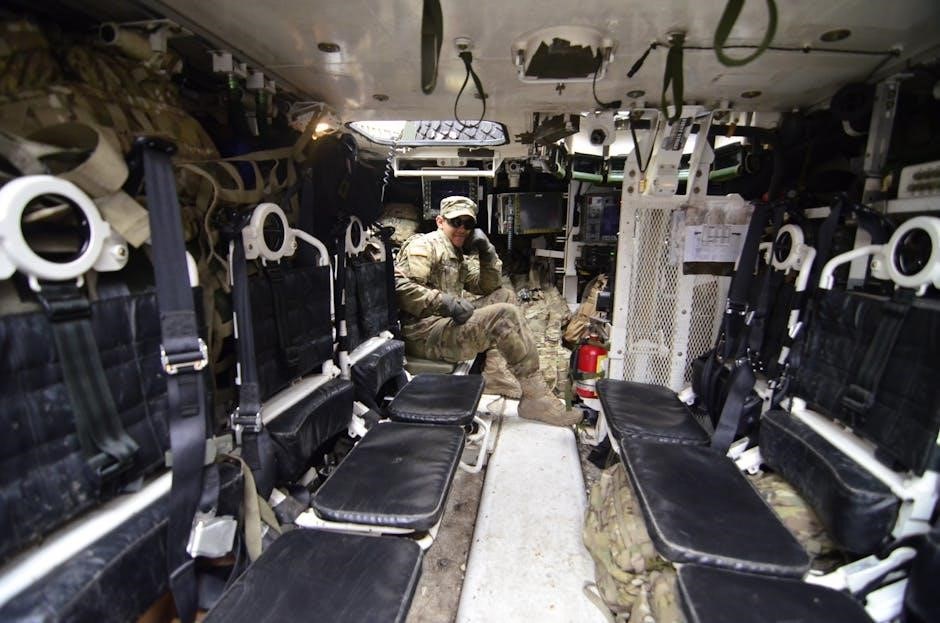
Manual restraint involves physical techniques to safely handle animals, ensuring both handler and subject safety. It employs holds, positioning, and devices to minimize stress and risk.
1.1 Definition and Purpose of Manual Restraint
Manual restraint refers to the use of physical techniques and devices to safely manage and control animals, ensuring minimal stress and risk to both the handler and the subject. It involves careful handling methods, such as holds or body positioning, to maintain control while performing procedures or examinations. The primary purpose is to ensure safety, prevent injury, and facilitate effective care or treatment. Manual restraint is often employed in veterinary medicine, animal handling, and research settings to maintain order and protect both humans and animals. Proper techniques are essential to minimize discomfort and ethical concerns.
1.2 Historical Context and Evolution
Manual restraint has ancient origins, with early humans using physical methods to manage animals for survival and care. Over centuries, techniques evolved to balance safety and humane practices. Ancient civilizations developed basic holds and devices, while modern advancements introduced refined methods. The shift from brute force to controlled, ethical practices emerged in the 20th century, emphasizing animal welfare. Today, manual restraint integrates scientific understanding, training, and technology to minimize stress and injury. Historical developments highlight the transition from primitive to precise techniques, reflecting societal and ethical advancements in animal handling and management.

Methods and Techniques of Manual Restraint
Manual restraint employs physical holds, positioning, and devices to control animals safely. Techniques include one- and two-handed methods for small animals and muzzle applications to minimize stress and injury.
2.1 Physical Holds and Body Positioning
Physical holds and body positioning are critical in manual restraint, ensuring control while minimizing injury risk. Handlers use techniques like gently lifting small animals by the torso or legs, maintaining stability. Proper positioning aligns the animal’s body with the handler’s, reducing movement. This approach helps in medical procedures, ensuring safety for both the handler and the subject. Effective holds and positioning require precision and training to avoid causing distress or harm.
2.2 One- and Two-Handed Techniques for Small Animals
One- and two-handed techniques are essential for restraining small animals effectively. The one-handed method involves gently lifting the animal by the torso or legs, providing control and accessibility for procedures. For larger small animals, two-handed techniques offer greater stability, with one hand supporting the body and the other guiding the head or limbs. Proper training ensures minimal stress and injury risk. These techniques are widely used in veterinary and laboratory settings to facilitate safe handling and medical interventions. Mastery of these methods requires practice and understanding of animal behavior to ensure humane and effective restraint.

2.3 Use of Muzzles and Other Restraint Devices
Muzzles are essential tools in manual restraint, designed to prevent biting and ensure handler safety. They are commonly used on dogs, cats, and other small animals. Muzzles come in various materials, such as nylon or leather, and should be fitted properly to avoid causing discomfort. Other restraint devices include Elizabethan collars, which prevent animals from licking or biting areas, and squeeze cages, used primarily for restraining wildlife. These devices help minimize the risk of injury during handling and medical procedures. Proper training is crucial to ensure the ethical and effective use of such restraint methods, balancing safety with animal welfare.


Safety Guidelines and Precautions
Ensure handler safety by using proper techniques, disinfecting equipment, and minimizing force. Prioritize animal welfare to prevent stress and injury during manual restraint procedures.
3.1 Preparation and Disinfection of Equipment

Proper preparation and disinfection of equipment are critical to ensure safety and hygiene during manual restraint. Gloves, forceps, and any tools used must be disinfected before and between uses to prevent disease transmission. This step is especially important when handling multiple animals to avoid cross-contamination. All equipment should be cleaned with appropriate disinfectants and allowed to dry completely before reuse. Regular maintenance of restraint devices, such as muzzles or harnesses, is also essential to ensure they function correctly and safely. Following these protocols helps protect both the handler and the animal from potential health risks associated with improper equipment handling.
3.2 Minimizing Risk of Injury to Handler and Subject
Minimizing injury during manual restraint requires careful technique and awareness. Handlers should use proper lifting methods to avoid straining and ensure the animal’s body is well-supported. Gentle yet firm holds reduce the risk of sudden movements. Monitoring the animal’s behavior and physical condition is crucial to anticipate potential reactions. Proper training ensures handlers can respond safely and effectively, reducing the likelihood of accidents. Using appropriate restraint devices and maintaining a calm environment further minimize risks. Ensuring the animal’s airway and circulation are not compromised is essential to prevent harm. Prioritizing the well-being of both handler and subject is fundamental in all restraint situations.
Legal and Ethical Considerations
Manual restraint must comply with legal standards and ethical guidelines to ensure animal welfare and handler accountability, balancing safety with humane treatment.
4.1 Regulatory Frameworks Governing Manual Restraint
Regulatory frameworks govern manual restraint to ensure ethical and safe practices. Laws like the Animal Welfare Act and European Directive 2010/63/EU regulate handling methods, emphasizing minimization of distress and humane treatment. These frameworks require handlers to use restraint only when necessary, with trained personnel, and to avoid causing harm. Compliance with these standards is legally mandated, ensuring accountability and protection for both animals and handlers. Violations can result in legal consequences, underscoring the importance of adherence. These regulations are regularly updated to reflect advances in animal welfare science and ethical handling practices.
4.2 Ethical Implications in Animal Handling
Manual restraint raises ethical considerations, emphasizing respect for animal welfare and minimizing distress. Ethical practices prioritize the well-being of animals, ensuring restraint is used only when necessary and with trained personnel. Handlers must balance the need for control with the animal’s right to humane treatment. Ethical guidelines advocate for minimizing pain, stress, and discomfort, promoting alternatives when possible. Transparency and accountability are crucial, with clear justification for restraint use. Ethical frameworks encourage continuous improvement in techniques and adherence to welfare standards, fostering trust and responsibility in animal handling practices.

Training and Best Practices
Proper training is essential for effective and safe manual restraint. Handlers should master techniques, understand animal behavior, and follow established protocols to minimize risks and stress.
5.1 Importance of Proper Training
Proper training in manual restraint is crucial for ensuring the safety of both handlers and animals. It equips handlers with the skills to apply techniques correctly, minimizing the risk of injury or stress. Training also fosters confidence and competence, enabling handlers to respond appropriately in various situations. Without adequate training, manual restraint can lead to improper methods, potentially causing harm. Therefore, comprehensive training programs are essential to teach handlers how to use holds, devices, and strategies effectively, promoting a safe and humane environment for animal handling.
5.2 De-escalation Techniques and Positive Support Strategies
De-escalation techniques are critical in manual restraint to prevent conflicts and ensure safety. These strategies focus on calming the subject through gentle, non-threatening approaches, such as gradual movements and soothing communication. Positive support involves creating a stress-free environment, using tools like muzzles or gloves to minimize discomfort. Handlers are trained to recognize early signs of distress and respond appropriately, prioritizing the well-being of both the handler and the animal. Proper training in de-escalation ensures that manual restraint is applied humanely, reducing risks and fostering trust. These methods are integral to ethical animal handling practices, emphasizing compassion and efficiency.
Alternatives to Manual Restraint
Alternatives include mechanical devices, pharmacological methods, and non-invasive solutions to minimize stress and risk, promoting humane and efficient handling of animals without physical force.
6.1 Mechanical and Pharmacological Restraint Methods
Mechanical restraint methods include devices like traps and muzzles, which temporarily limit animal movement without physical contact. Pharmacological restraint involves administering sedatives or anesthetics to calm subjects, reducing handling risks. These alternatives minimize stress and potential injury, offering humane solutions for animal control. Mechanical devices ensure safety during procedures, while pharmacological approaches provide controlled immobilization, particularly useful in veterinary settings. Both methods are employed when manual restraint is impractical or risky, ensuring efficient and stress-free handling of animals in various scenarios, from wildlife management to medical procedures.
6.2 Non-invasive and Humane Restraint Solutions
Non-invasive restraint solutions prioritize animal welfare by minimizing physical contact and stress. Techniques include positive reinforcement, such as food rewards, to encourage cooperation. Environmental modifications, like calm spaces, reduce anxiety. These methods focus on psychological comfort, avoiding forceful handling. Tools like gloves or towels may be used to gently guide animals without causing harm. Monitoring behavior ensures interventions are humane and ethical. Training handlers in these approaches is crucial for successful implementation. Such solutions align with modern ethical standards, promoting stress-free handling and respect for animal well-being in various settings, from veterinary care to wildlife conservation.